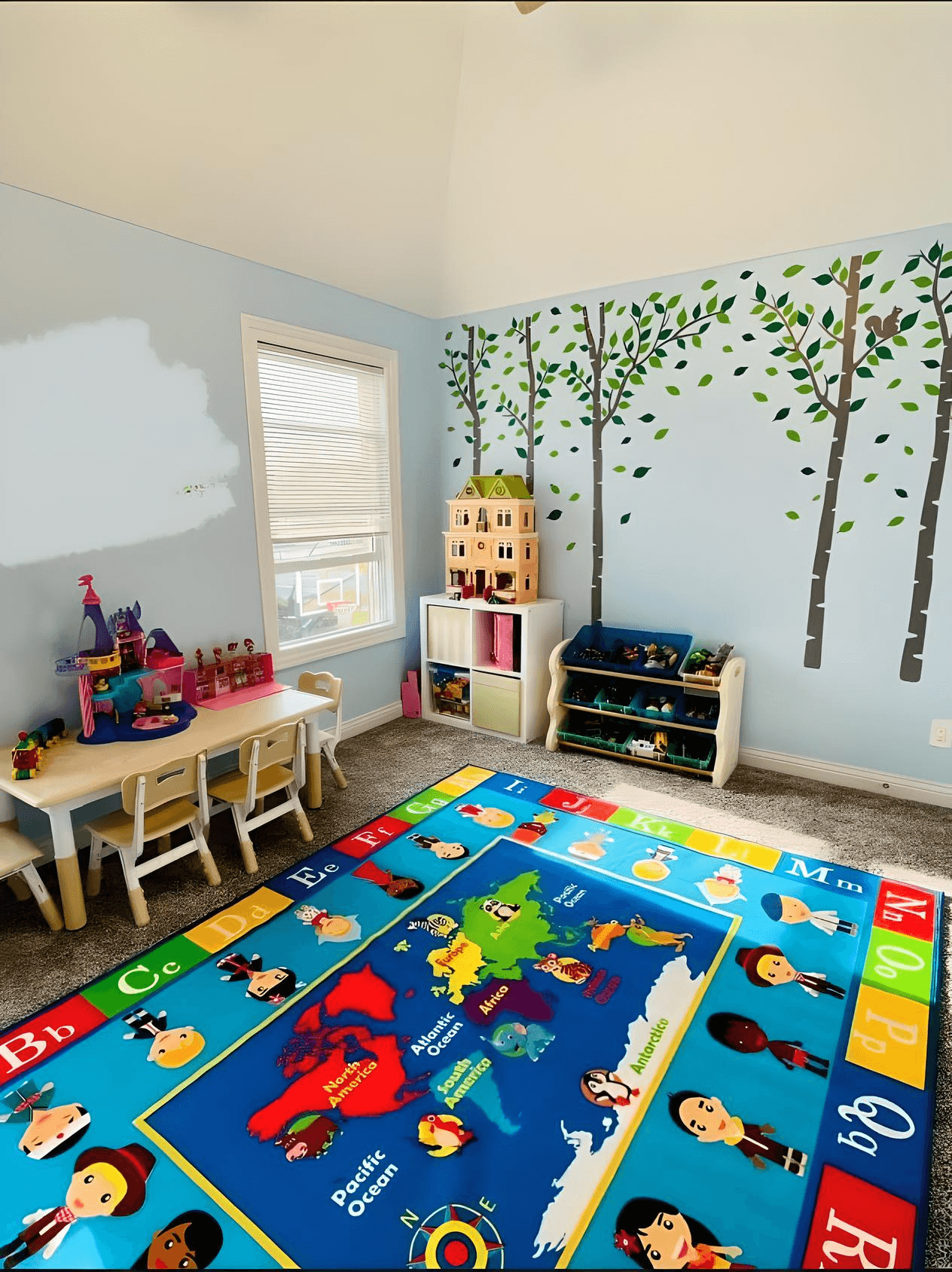Selecting the right classroom rug for learning environments isn't just about aesthetics or durability—it's about supporting children's developmental needs at each stage of growth.
The ideal carpet for an infant room differs significantly from one designed for upper elementary students.
This comprehensive guide examines how to align carpet selection with the developmental characteristics and learning needs of different age groups, ensuring that your flooring choice actively contributes to children's growth, safety, and educational experiences.
Infants (0-18 months): Sensory Exploration and Motor Development
Infants experience the world primarily through sensory exploration and are developing crucial motor skills like rolling, crawling, and early walking attempts.
Key Developmental Considerations
- Heightened sensory sensitivity
- Floor-based exploration
- Developing immune systems
- Frequent spills and accidents
- Tummy time and crawling practice
Ideal Carpet Characteristics for Infants
Texture and Pile
Infants benefit from carpets with varied but gentle textures that provide tactile stimulation without irritation. Infant development research indicates that tactile exploration is fundamental to cognitive development during this stage.
Recommended: Low-to-medium pile pastel classroom rugs with soft, smooth textures and minimal pattern variations that won't overwhelm developing sensory systems.
Avoid: High-pile carpets that can interfere with crawling or cause face-planting during early walking attempts; abrasive textures that might irritate sensitive skin.
Material Selection
Given infants' tendency to engage in hand-to-mouth activities and spend significant time in direct contact with flooring, material safety is paramount.
Recommended: Natural fibers like wool or organic cotton blends with minimal chemical treatments; synthetic options with Greenguard Gold certification ensuring minimal VOC emissions.
Avoid: Carpets with stain-resistant treatments containing perfluorinated compounds (PFCs), which may pose health risks to developing infants.
Design Elements
Simple, high-contrast patterns support visual development while providing visual stimulation that aids in focus development.
Recommended: Gentle, high-contrast patterns in black, white, and primary colors that support visual tracking skills; simple geometric shapes that introduce early math concepts.
Avoid: Overly complex patterns that can overwhelm developing visual systems; small intricate designs that can harbor bacteria in infant environments.
Safety Features
Safety considerations dominate all other factors for infant environments.
Recommended: Hypoallergenic options with antimicrobial properties; carpet tiles that allow for easy replacement of soiled sections; non-slip backing essential for early walkers.
Avoid: Carpets with loose fibers that could pose choking hazards; adhesives containing high VOC levels.
Toddlers (18-36 months): Mobility Mastery and Independence
Toddlers are defined by their increasing mobility, emerging independence, and rapid language development.
Their carpeting needs balance physical activity support with early learning opportunities.
Key Developmental Considerations
- High physical activity levels
- Frequent falls during skill acquisition
- Developing spatial awareness
- Increasing independence in play
- Early categorization and sorting skills
Ideal Carpet Characteristics for Toddlers
Durability and Cushioning
Toddlers are notoriously active, making durability and impact absorption critical features for their environments.
Recommended: Medium-density carpet with enhanced cushioning; commercial-grade options with crush-resistant fibers that maintain appearance despite heavy use; carpet tiles with heavy-duty backing.
Avoid: Delicate loop constructions that can snag from toddler activities; excessively padded options that might make balance more challenging for new walkers.
Educational Design Elements
Early childhood educators emphasize that environmental design significantly impacts toddler learning. Carpet can become an active teaching tool during this developmental stage.
Recommended: Simple counting elements (1-10) embedded in design; basic color identification patterns; directional pathways that encourage movement exploration.
Avoid: Overly "busy" educational designs that detract from focused play; small elements that could create visual confusion.
Zoning Support
Toddler classrooms benefit from clear activity zones that support developing autonomy and decision-making.
Recommended: Distinct colorful classroom rugs to designate different activity areas (quiet reading, active play, group gathering); border elements that help toddlers understand spatial boundaries.
Avoid: Confusing transitions between activity zones; patterns that create visual "vibration" effects which can be disorienting to developing visual systems.
Practical Considerations
Accidents and spills remain common during the toddler years, requiring practical material choices.
Recommended: Solution-dyed nylon or polypropylene fibers with excellent stain resistance; moisture-barrier backing; modular installation methods allowing for easy replacement of damaged sections.
Avoid: Light, solid colors that show every mark; wool in high-traffic toddler environments due to cleaning challenges and higher maintenance requirements.
Preschoolers (3-5 years): Imaginative Play and Social Development
Preschoolers engage deeply in imaginative play, social interaction, and more structured learning activities. Their carpet needs combine functional durability with enhanced educational features.
Key Developmental Considerations
- Rich imaginative play
- Developing social skills
- Emerging literacy and numeracy
- Group learning activities
- Circle time participation
- Growing focus duration
Ideal Carpet Characteristics for Preschoolers
Interactive Learning Elements
Preschool carpets can actively support curriculum objectives through thoughtful design elements.
Recommended: Alphabet designs that support letter recognition; number sequences with corresponding quantities; simple map elements introducing geographic concepts; calendar features supporting time concepts.
According to early childhood research, environmental print—including text and numbers in classroom furnishings—significantly enhances literacy development.
Avoid: Overly complex educational elements that may overwhelm or confuse; designs that quickly become outdated with curriculum changes.
Circle Time Functionality
Group gatherings become increasingly important in preschool environments.
Recommended: Circular classroom seating rugs with individual sitting spots clearly marked; arrangements that naturally guide children into semi-circle formations; subtle teacher position indicators.
Avoid: Circle time carpets with inadequate spacing between sitting positions; designs that don't accommodate expanding class sizes.
Social Interaction Support
Carpet design can enhance social skill development through thoughtful layout.
Recommended: Small group interaction zones designated by carpet design; friendship benches or special meeting spots integrated into carpet patterns; collaborative game elements woven into carpet design.
Avoid: Designs that isolate children or create territory disputes; inadequate space planning for social distance requirements.
Practical Features
Preschool environments require highly practical carpet choices that balance appearance with function.
Recommended: Commercial-grade carpeting with crush-resistant fibers; anti-microbial treatments to reduce illness spread; stain-resistant treatments safe for extended child contact.
Avoid: Light color palettes in high-traffic areas; deep pile carpets that trap art supplies and small manipulatives common in preschool settings.
Early Elementary (5-8 years): Structured Learning and Skill Building
Early elementary students engage in more structured learning while developing critical academic and social skills. Their carpeting should support this transition to formal education.
Key Developmental Considerations
- Increasing structured learning
- Developing fine motor coordination
- Growing attention spans
- Collaborative project work
- Early research activities
- Reading skill development
Ideal Carpet Characteristics for Early Elementary
Learning Center Support
Early elementary classrooms typically utilize learning centers for differentiated instruction.
Recommended: Distinct carpet areas designating different learning centers; subtle transitions between carpet sections to guide movement flow; color coding that aligns with classroom organization systems.
Avoid: Harsh transitions between flooring types that create tripping hazards; designs that limit furniture arrangement flexibility.
Acoustic Considerations
As academic expectations increase, sound management becomes increasingly important for concentration.
Recommended: Higher density carpets with enhanced acoustic properties; carpet installation with quality padding; textured designs that further absorb sound waves.
Educational environment studies indicate that proper acoustic treatments, including appropriate carpeting, can improve reading scores by reducing auditory distractions.
Avoid: Thin carpeting installed directly over concrete without padding; carpet tiles installed without attention to overall acoustic performance.
Collaborative Work Spaces
Early elementary students engage frequently in partner and small group work.
Recommended: Large classroom rugs that naturally define small group work areas; subtle boundary markers in carpet design; durable areas that withstand desk and chair movement.
Avoid: Carpeting too delicate for furniture movement; designs that don't allow for flexible grouping arrangements.
Academic Integration
Carpet can reinforce academic content being taught in early elementary grades.
Recommended: Hundred-charts embedded in carpet design; simple word families; basic geometry concepts; patterns that support skip counting.
Avoid: Overly simple designs better suited to younger children; content-specific designs that quickly become irrelevant to curriculum.
Upper Elementary (8-11 years): Independence and Analytical Thinking
Upper elementary students develop greater independence, abstract thinking skills, and subject-matter expertise. Their carpet needs focus on supporting more sophisticated learning activities.
Key Developmental Considerations
- Growing independence
- Developing abstract thinking
- Increased project-based learning
- Peer collaboration importance
- Digital integration
- Subject specialization
Ideal Carpet Characteristics for Upper Elementary
Sophisticated Design Elements
Upper elementary students benefit from more complex design elements that challenge their developing analytical skills.
Recommended: Coordinate grids supporting math concepts; more subtle educational elements that don't appear childish; designs incorporating fractions and decimals; geometric patterns with increasing complexity.
Avoid: Overly juvenile designs that students may find patronizing; themes better suited to younger children.
Technology Integration
Today's upper elementary classrooms incorporate significant technology use.
Recommended: Static-dissipative carpet fibers in computer areas; carpet tiles with embedded cable management; designated tech zones with appropriate flooring considerations.
Avoid: High-static carpet materials near technology areas; inadequate planning for charging station locations.
Collaborative Space Definition
Upper elementary collaboration becomes more sophisticated and project-based.
Recommended: Clearly defined collaborative zones, and quiet reflection spaces designated through a dedicated reading rug.
Avoid: Rigid space definitions that don't accommodate project-based learning needs; insufficient attention to acoustic separation between work zones.
Professional Atmosphere
Older elementary students respond well to more sophisticated, "grown-up" environments.
Recommended: More subdued color palettes that create a professional atmosphere; designs that feel respectful of developing maturity; patterns that transition well to middle school environments.
Avoid: Primary color schemes better suited to early childhood; overly playful designs that may feel infantilizing to older elementary students.
Maintenance Considerations Across Age Groups
Regardless of age group, maintenance requirements significantly impact carpet longevity and performance in educational settings.
Infant and Toddler Spaces
- Daily vacuuming essential
- Weekly hot water extraction in high-contact areas
- Quarterly professional deep cleaning
- Immediate attention to biological spills
- Carpet protection during messy activities
Preschool Environments
- Spot-cleaning protocols for frequent small spills
- Regular sanitization schedule
- Modular replacement program for high-wear sections
- Entrance matting to reduce outside contaminants
- Teacher-friendly cleaning solutions for immediate needs
Elementary Settings
- Student participation in basic maintenance
- Preventative approaches for project areas
- Designated clean-up protocols following activities
- Seasonal deep cleaning during school breaks
- Strategic furniture placement to distribute wear
Environmental Factors and Health Considerations
Children's developing systems may be more vulnerable to environmental toxins, making health considerations paramount in carpet selection.
Indoor Air Quality
Carpet can significantly impact indoor air quality, particularly in spaces where children spend extended time on or near the floor.
Best Practices:
- Select products with Green Label Plus certification
- Choose low-VOC adhesives for installation
- Implement proper ventilation during and after installation
- Consider carpet extraction frequency based on age group contact levels
- Select appropriate backing materials for moisture management
Allergy Considerations
With increasing allergy concerns in childhood environments, thoughtful carpet selection can help mitigate issues.
Best Practices:
- Select tight-weave, low-pile carpets that trap fewer allergens
- Implement appropriate vacuum protocols using HEPA filtration
- Consider antimicrobial treatments for infant and toddler areas
- Maintain appropriate humidity levels to discourage dust mite proliferation
- Choose carpet tiles that allow for selective replacement in problem areas
Conclusion
Thoughtful carpet selection based on developmental needs creates learning environments that actively support children's growth rather than merely providing a floor covering.
By considering the unique characteristics of each age group—from the sensory exploration of infants to the collaborative project work of upper elementary students—educators and facility planners can make informed decisions that enhance educational experiences.
Remember that the ideal carpet becomes an active participant in the learning environment: providing sensory stimulation for crawling infants, clear activity boundaries for active toddlers, engaging educational elements for curious preschoolers, and sophisticated learning supports for elementary students.
When selected with developmental needs in mind, carpet transforms from a basic facility necessity into a valuable teaching tool that supports children throughout their educational journey.




Leave a comment
This site is protected by hCaptcha and the hCaptcha Privacy Policy and Terms of Service apply.